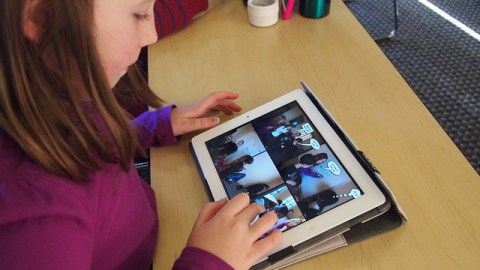No Laptop for You! (Until You Set Goals)

A teacher friend of mine wrote me recently. She said that her school was working on bringing in iPads for grades six and seven next year and asked if I find that schools prefer laptops to iPads when moving to a 1:1 device environment.
That’s a question our center gets quite a bit. In the end, our advice is: be sure your school defines clear goals for what it seeks to achieve by having computing devices in the hands of its students.
For instance, if writing is an important goal, you probably want a device with a physical keyboard — so laptops are a good choice. Schools that are integrating writing across the curriculum, for instance, would want to take this into account.
But if your goals are about enhancing overall student engagement with material, then tablets may be the way to go. iPads are excellent for giving students access to information. If enhancing creative capabilities of students is critical, then laptops may be the way to go because of the wider array of applications and the ability save creative work to disk and share it across platforms (print, web, etc).
Regardless, it’s the setting of goals that’s important. It transcends most other school factors in determining 1:1 success. For instance, we’ve seen schools issue iPads to students but not do a good job of expectation setting and training only to have teachers leave the school because of it. Perhaps that’s a worst-case scenario, but it’s emblematic of the bad feelings that can creep in to the teacher ranks when changes are not well communicated. Other schools that have aligned curriculum, trained teachers, set clear expectations, etc. have students doing amazing things. The schools that are really good at this don’t call themselves 1:1 schools, even if they technically are. Take for instance the Science Leadership Academy in Philadelphia. They have five core values in their school, none of which are about technology. However, they do use technology to fulfill those values:
They are now doing things that are unimaginable without the devices. And they got there because they had broad agreement across their school’s stakeholders about what the goals should be. My colleague Nick Sauers talks about this in a post he wrote a while back. He notes:
“One to one learning is one way to enhance what students learn and the ways that they learn. It can turn teacher centered classrooms into student centered classrooms. More importantly, it can move students from the bottom of Bloom’s Taxonomy to the top level where students create…Unfortunately, one to one could also serve as a tool to promote the ways things have always been done. (The key is to) truly identify what students should learn and make those things the focus of everything the school does.”
Is your school thinking about implementing a 1:1 laptop policy? Some things to be aware of might include:
What else should a school embarking on a 1:1 journey keep in mind?
Photo Credit: (cc) Flickr user flickingerbrad





